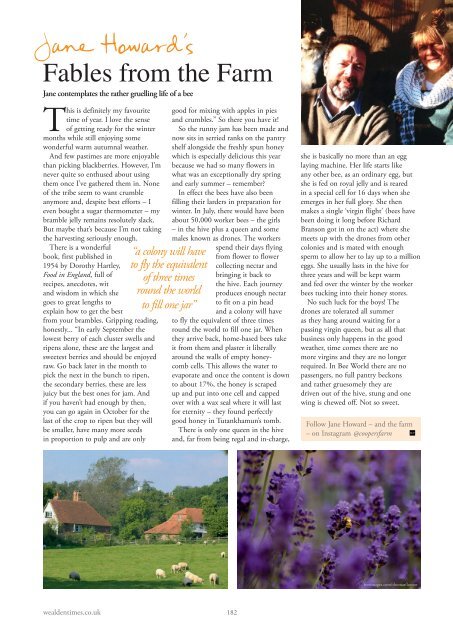Wealden Times | WT188 | October 2017 | Kitchen & Bathroom supplement inside
Wealden Times - The lifestyle magazine for the Weald
Wealden Times - The lifestyle magazine for the Weald
Create successful ePaper yourself
Turn your PDF publications into a flip-book with our unique Google optimized e-Paper software.
Jane Howard’s<br />
Fables from the Farm<br />
Jane contemplates the rather gruelling life of a bee<br />
This is definitely my favourite<br />
time of year. I love the sense<br />
of getting ready for the winter<br />
months while still enjoying some<br />
wonderful warm autumnal weather.<br />
And few pastimes are more enjoyable<br />
than picking blackberries. However, I’m<br />
never quite so enthused about using<br />
them once I’ve gathered them in. None<br />
of the tribe seem to want crumble<br />
anymore and, despite best efforts – I<br />
even bought a sugar thermometer – my<br />
bramble jelly remains resolutely slack.<br />
But maybe that’s because I’m not taking<br />
the harvesting seriously enough.<br />
There is a wonderful<br />
book, first published in<br />
1954 by Dorothy Hartley,<br />
Food in England, full of<br />
recipes, anecdotes, wit<br />
and wisdom in which she<br />
goes to great lengths to<br />
explain how to get the best<br />
from your brambles. Gripping reading,<br />
honestly... “In early September the<br />
lowest berry of each cluster swells and<br />
ripens alone, these are the largest and<br />
sweetest berries and should be enjoyed<br />
raw. Go back later in the month to<br />
pick the next in the bunch to ripen,<br />
the secondary berries, these are less<br />
juicy but the best ones for jam. And<br />
if you haven’t had enough by then,<br />
you can go again in <strong>October</strong> for the<br />
last of the crop to ripen but they will<br />
be smaller, have many more seeds<br />
in proportion to pulp and are only<br />
“a colony will have<br />
to fly the equivalent<br />
of three times<br />
round the world<br />
to fill one jar”<br />
good for mixing with apples in pies<br />
and crumbles.” So there you have it!<br />
So the runny jam has been made and<br />
now sits in serried ranks on the pantry<br />
shelf alongside the freshly spun honey<br />
which is especially delicious this year<br />
because we had so many flowers in<br />
what was an exceptionally dry spring<br />
and early summer – remember?<br />
In effect the bees have also been<br />
filling their larders in preparation for<br />
winter. In July, there would have been<br />
about 50,000 worker bees – the girls<br />
– in the hive plus a queen and some<br />
males known as drones. The workers<br />
spend their days flying<br />
from flower to flower<br />
collecting nectar and<br />
bringing it back to<br />
the hive. Each journey<br />
produces enough nectar<br />
to fit on a pin head<br />
and a colony will have<br />
to fly the equivalent of three times<br />
round the world to fill one jar. When<br />
they arrive back, home-based bees take<br />
it from them and plaster it liberally<br />
around the walls of empty honeycomb<br />
cells. This allows the water to<br />
evaporate and once the content is down<br />
to about 17%, the honey is scraped<br />
up and put into one cell and capped<br />
over with a wax seal where it will last<br />
for eternity – they found perfectly<br />
good honey in Tutankhamun’s tomb.<br />
There is only one queen in the hive<br />
and, far from being regal and in-charge,<br />
she is basically no more than an egg<br />
laying machine. Her life starts like<br />
any other bee, as an ordinary egg, but<br />
she is fed on royal jelly and is reared<br />
in a special cell for 16 days when she<br />
emerges in her full glory. She then<br />
makes a single ‘virgin flight’ (bees have<br />
been doing it long before Richard<br />
Branson got in on the act) where she<br />
meets up with the drones from other<br />
colonies and is mated with enough<br />
sperm to allow her to lay up to a million<br />
eggs. She usually lasts in the hive for<br />
three years and will be kept warm<br />
and fed over the winter by the worker<br />
bees tucking into their honey stores.<br />
No such luck for the boys! The<br />
drones are tolerated all summer<br />
as they hang around waiting for a<br />
passing virgin queen, but as all that<br />
business only happens in the good<br />
weather, time comes there are no<br />
more virgins and they are no longer<br />
required. In Bee World there are no<br />
passengers, no full pantry beckons<br />
and rather gruesomely they are<br />
driven out of the hive, stung and one<br />
wing is chewed off. Not so sweet.<br />
Follow Jane Howard – and the farm<br />
– on Instagram @coopersfarm<br />
freeimages.com/thomasfleenor<br />
wealdentimes.co.uk<br />
182


















